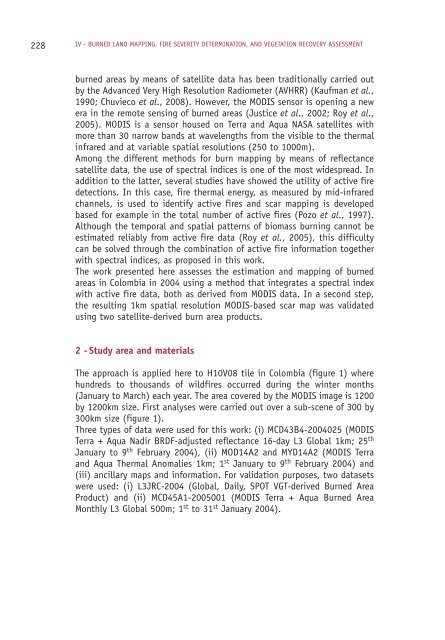7th Workshop on Forest Fire Management - EARSeL, European ...
7th Workshop on Forest Fire Management - EARSeL, European ...
7th Workshop on Forest Fire Management - EARSeL, European ...
Create successful ePaper yourself
Turn your PDF publications into a flip-book with our unique Google optimized e-Paper software.
228<br />
IV - BURNED LAND MAPPING, FIRE SEVERITY DETERMINATION, AND VEGETATION RECOVERY ASSESSMENT<br />
burned areas by means of satellite data has been traditi<strong>on</strong>ally carried out<br />
by the Advanced Very High Resoluti<strong>on</strong> Radiometer (AVHRR) (Kaufman et al.,<br />
1990; Chuvieco et al., 2008). However, the MODIS sensor is opening a new<br />
era in the remote sensing of burned areas (Justice et al., 2002; Roy et al.,<br />
2005). MODIS is a sensor housed <strong>on</strong> Terra and Aqua NASA satellites with<br />
more than 30 narrow bands at wavelengths from the visible to the thermal<br />
infrared and at variable spatial resoluti<strong>on</strong>s (250 to 1000m).<br />
Am<strong>on</strong>g the different methods for burn mapping by means of reflectance<br />
satellite data, the use of spectral indices is <strong>on</strong>e of the most widespread. In<br />
additi<strong>on</strong> to the latter, several studies have showed the utility of active fire<br />
detecti<strong>on</strong>s. In this case, fire thermal energy, as measured by mid-infrared<br />
channels, is used to identify active fires and scar mapping is developed<br />
based for example in the total number of active fires (Pozo et al., 1997).<br />
Although the temporal and spatial patterns of biomass burning cannot be<br />
estimated reliably from active fire data (Roy et al., 2005), this difficulty<br />
can be solved through the combinati<strong>on</strong> of active fire informati<strong>on</strong> together<br />
with spectral indices, as proposed in this work.<br />
The work presented here assesses the estimati<strong>on</strong> and mapping of burned<br />
areas in Colombia in 2004 using a method that integrates a spectral index<br />
with active fire data, both as derived from MODIS data. In a sec<strong>on</strong>d step,<br />
the resulting 1km spatial resoluti<strong>on</strong> MODIS-based scar map was validated<br />
using two satellite-derived burn area products.<br />
2 - Study area and materials<br />
The approach is applied here to H10V08 tile in Colombia (figure 1) where<br />
hundreds to thousands of wildfires occurred during the winter m<strong>on</strong>ths<br />
(January to March) each year. The area covered by the MODIS image is 1200<br />
by 1200km size. First analyses were carried out over a sub-scene of 300 by<br />
300km size (figure 1).<br />
Three types of data were used for this work: (i) MCD43B4-2004025 (MODIS<br />
Terra + Aqua Nadir BRDF-adjusted reflectance 16-day L3 Global 1km; 25 th<br />
January to 9 th February 2004), (ii) MOD14A2 and MYD14A2 (MODIS Terra<br />
and Aqua Thermal Anomalies 1km; 1 st January to 9 th February 2004) and<br />
(iii) ancillary maps and informati<strong>on</strong>. For validati<strong>on</strong> purposes, two datasets<br />
were used: (i) L3JRC-2004 (Global, Daily, SPOT VGT-derived Burned Area<br />
Product) and (ii) MCD45A1-2005001 (MODIS Terra + Aqua Burned Area<br />
M<strong>on</strong>thly L3 Global 500m; 1 st to 31 st January 2004).
















